WOLF POINT
Confluence of the North, South, and Main Branches of the Chicago River
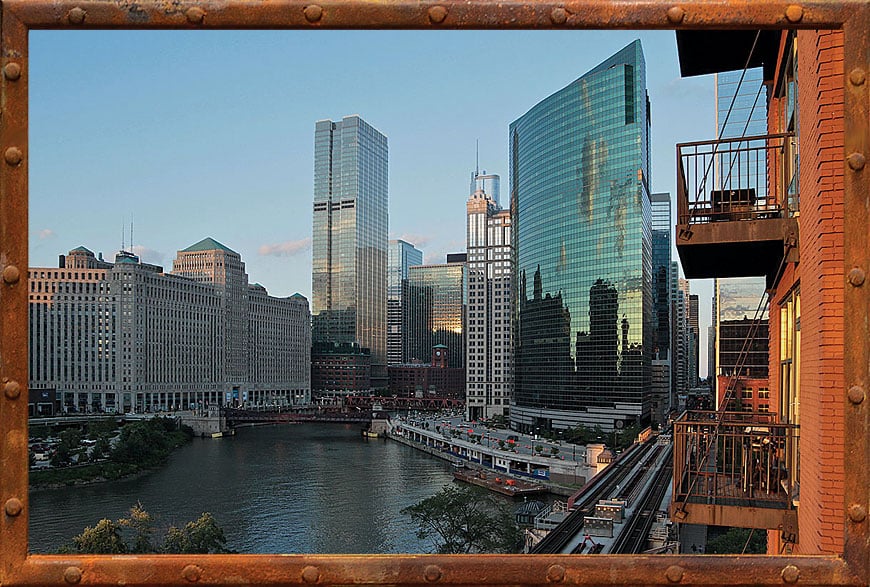
Wolf Point today is a sleek, modern confluence of skyscrapers and waterways. It is one of Chicago’s most storied and important intersections. Photo Credit: Alan Brunettin
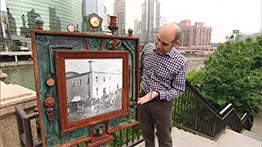
Watch the Segment
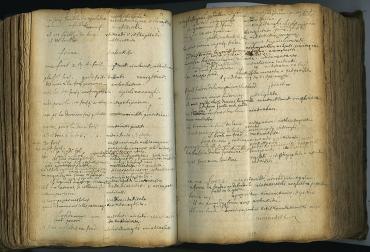
A French-Miami Indian dictionary written by Father Pierre François Pinet, a Jesuit missionary, is the first book written in Chicago. It was discovered in 1999 at an archive in Canada. Among other Indian words translated in the Pinet dictionary is the word for “striped skunk” – an impolite term for the wild leek plant. They pronounced that word shikaakwa; we pronounce it “Chicago.” Photo Credit: Jesuit Archives of Canada
LEARN MORE
Read about Mission of the Guardian Angel at Chicago established in 1696.
Read about Mark Beaubien and the Sauganash Hotel.
Read about the Wigman, the site of the 1860 Republican National Convention.
The confluence of the north, south and main branches of the Chicago River, just west of the Merchandise Mart, is a critical connecting point in Chicago’s geography and in its history.
This is the spot where early explorers and traders would head south, toward the Chicago portage. For that reason, it was both a major intersection and a social hub.
The original Wolf Point, on the west bank of the confluence, gets its name from a Potawatomi Indian who once lived there. His name, Mo-ah-way, can be translated as wolf. Today, the term “Wolf Point” is often used to refer to any of the three banks.
A few of the many interesting things that have come and gone at Wolf Point over the years:
Guardian Angel Mission
In 1696, Father Pierre François Pinet, a Jesuit missionary, came to Chicago from another Jesuit mission at Michilimackinac (near current-day Mackinaw City) and established la Mission de l’Ange Gardien – the Guardian Angel Mission.
Chicago’s first resident clergyman served both Native Americans – specifically, the local Miami Indians – and French fur traders who might stop on their way through to points west. Though the location remains unconfirmed, his mission most likely sat on the current site of the Merchandise Mart.
During his six years here, he also wrote the first known book authored in Chicago: a 672-page French-Miami dictionary. Indiana University linguist Michael McCafferty discovered the original, hand-written text in 1999 at a Jesuit archive near Montreal and identified Father Pinet as the author by comparing handwriting samples of Pinet and other missionaries of the era.
The Pinet dictionary includes French-Miami translations for such terms as bear, otter, beaver, and loon. It also tells us that the Illinois people called themselves “Inoka” – and that they called their big river to the west the “missisipi8i” (which they pronounced mihsisiipiiwi).
And the most interesting entry of all: the name of the allium, or wild leek plant, that would become the name of the city of Chicago: “chikag8a” (which they pronounced shikaakwa) – meaning “striped skunk.” The dictionary goes on to note that it is not a nice word to call this plant, just because it has a strong odor!
Sauganash Hotel
The early days of Chicago were populated with colorful characters, not the least of which was a hotel owner and ferryman named Mark Beaubien. He came to Chicago from Detroit in 1826 with his wife, Monique, and five children (he would ultimately father 23).
He purchased a log cabin from James Kinzie on the south bank of the confluence and expanded it with a two-story frame addition so he could take in guests. In 1831, he opened an inn called the Sauganash Hotel in honor of his friend Billy Caldwell, whose Indian name was Sauganash. The same year, he initiated Chicago’s first ferry service, taking people across the South Branch.
Beaubien loved to entertain his guests with his fiddle and telling stories in song. The Sauganash Hotel (also known as the Sauganash Tavern) at the corner of Lake Street and Market Street became a social center of a young Chicago. When the city was incorporated in 1833, the first elections took place at the Sauganash Hotel; many important town meetings occurred there, as well.
Beaubien sold the Sauganash Hotel in 1834, and it operated as under various owners and names until the building was destroyed by fire in 1851.
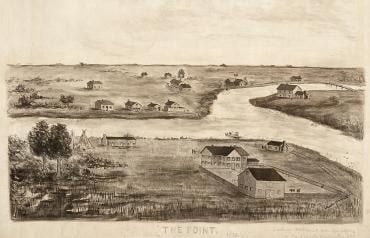
Wolf Point in 1833. It was a major intersection and social hub. Mark Beaubien’s Sauganash Hotel and ferry operation are in the foreground. The bridge at left came after the ferry operation. Photo Credit: Chicago History Museum

Mark Beaubien came to Chicago in 1826 with his wife, Monique, and five of the 23 children he would ultimately father. He was one of the colorful characters of early Chicago, with a portfolio of careers including hotelier, tavern-keeper, ferryman, lighthouse keeper, and tolltaker. Photo Credit: Chicago History Museum
Wigwam
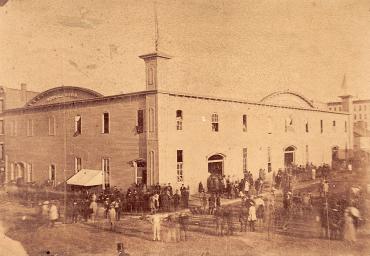
A building was needed to accommodate the 1860 Republican National Convention. In little more than a month, an all-wood auditorium was constructed on the site of the old Sauganash Hotel, which had burned in 1851. The Wigwam could hold 12,000 people. Photo Credit: Chicago History Museum
Nine years later, on the site of the old Sauganash Hotel, a building called the Wigwam was constructed to hold 12,000 people for the 1860 Republican National Convention.
An enthusiastic crowd came to hear Abraham Lincoln. What his opponents didn’t know is that his campaign had stacked the deck by passing out many counterfeit tickets to extra-loud crowd members, who shouted down the opposition and helped assure his nomination. Lincoln would go on to serve as president during the young country’s most trying chapters, as the Civil War tore apart the country fewer than 100 years after it was founded.
The Wigwam was destroyed in the Great Fire of 1871.
Lost Tributary
Before 1850, an additional “branch” of the Chicago River can be seen on maps and illustrations of the area, forking to the north, where the Merchandise Mart now sits.
Not so much a branch as a twig, this small tributary must have been drained or filled in by 1848; in maps after that, only the slightest hint of it can be seen.
The Future
Development plans currently call for three tall towers to be built on the north bank of the confluence in the area that protrudes into the river south of the Sun-Times building. Neighbors and critics were asking for a review of those plans as of late 2013.
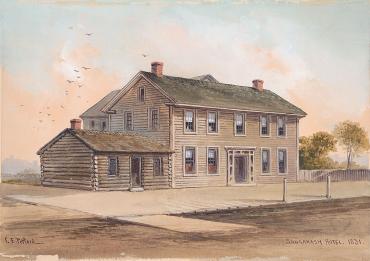
Beaubien purchased a log cabin and expanded it with a two-story frame addition. It became the Sauganash Hotel (also known as the Sauganash Tavern), a center of social and civic life in early Chicago. Photo Credit: Chicago History Museum
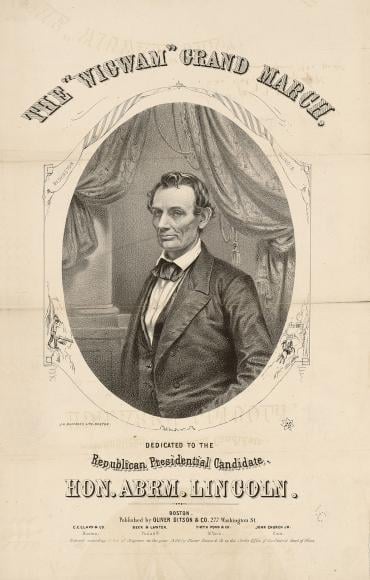
Abraham Lincoln received the Republican nomination and went on to lead the nation through its most difficult hours. Photo Credit: Chicago History Museum
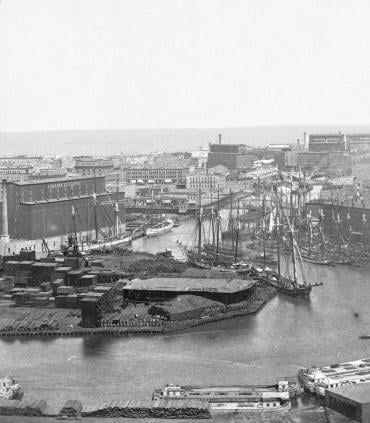
The view eastward from Wolf Point, circa 1885. After the Great Fire of 1871, a dramatic period of rebuilding saw Chicago’s entire downtown transformed, including the area along the river. Bigger, better, bolder, and “brick-er” were the watchwords. Photo Credit: Chicago History Museum
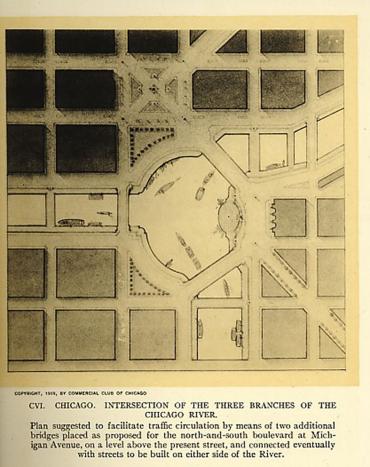
Add one more “B,” for Burnham: Daniel Burnham’s unrealized plan for Wolf Point would have added two diagonal bridges in a semi-circular format. Photo Credit: Public Domain

Currently in the works for the north bank of the confluence, adjacent the Sun-Times building, is a developer’s plan for three tall towers. Some are opposed to the plan.


